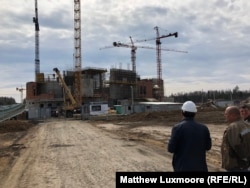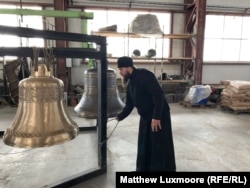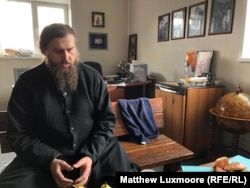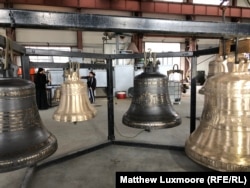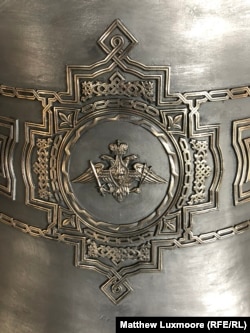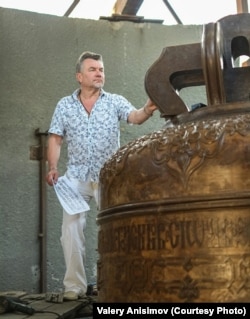VORONEZH, Russia -- Valery Anisimov's foundry has made bells for Russia's most iconic churches, helping ring in the postcommunist rebirth of Russian Orthodoxy.
So when he learned that the state was constructing a vast cathedral outside Moscow combining symbols of religion and military pride, the 63-year-old couldn't sit idly by. He gate-crashed a meeting of the planning board and said he'd supply the bells himself, free of charge.
"All the biggest bell projects in contemporary Russia are done with my involvement," he said the day after his foundry had cast the cathedral's final, 10-ton bell. "I couldn't allow an undertaking of this size to pass me by."
The Main Cathedral of Russian Armed Forces, set to become Russia's third-tallest Orthodox cathedral, is rising in a wooded clearing overlooking the highway on the grounds of Patriot Park, a military-themed recreation and expo complex opened by the Defense Ministry in 2016.
When it's unveiled one year from now -- on May 9, 2020, the 75th anniversary of the end of World War II -- it will be the set piece of an ostentatious memorial complex merging Russia's Orthodox tradition with the most sanctified episode of the country's past: the Soviet Union's victory over invading Nazi forces in what Russians call the Great Patriotic War.
Defense Minister Sergei Shoigu, who is credited with originating the idea, ordered that every square meter of the cathedral be symbolic.
Anisimov is one of hundreds of entrepreneurs, artists, and designers participating in a monumental construction project officially reliant on donations and free labor. But among those enlisted to help bring Shoigu's vision to life, some are uneasy about the militaristic tone of the project and the message it appears to send. And within the Orthodox Church -- whose leadership is actively involved in the planning -- there are fears that after decades of repression by the Soviet government, the institution has become entangled in the ideological offensive of its successor.
"This is an excessively vulgar involvement of the church in militarism and state affairs," said Sergei Chapnin, the former editor of the Moscow Patriarchate's official journal. "We have a secular state, and when it tries to involve the church in its campaigns, it's obvious it's not about faith but about government propaganda."
It's not just the project's extravagance that has turned heads.
The Defense Ministry has pulled out all the stops to elicit money from the public, but its fund-raising drive has remained opaque. No budget has been announced. And rumors of coercion have cast a dark shadow over the project.
Critics say the popular mobilization on which it depends -- the generosity of businesses involved, the free publicity needed to spread the word, and the billions of rubles in public donations to the cause -- masks a lack of genuine interest from a Russian public increasingly critical of a construction spree that has seen 25 churches built over the past year in the capital alone.
"There is no popular urge to gather money for the cathedral. This is a purely top-down initiative," said Aleksandr Golts, a military expert and editor of the online current affairs magazine Yezhednevny Zhurnal. "It's part of an effort by the armed forces to spearhead the campaign for a new, Russian ideology."
'Help With A Pure Soul'
The project taps into a long tradition. From the 12th century on, Russia has built churches to commemorate military victories: over Mongol invaders in the 14th century; over Swedes in the 18th; over Napoleon's Grande Armée in the 19th. They are scattered across the former empire, reminders of conquests past.
The Defense Ministry says the new cathedral will be the first devoted to the victory in the Great Patriotic War, a cornerstone of contemporary Russian identity. Its opening next May will form part of a grand celebration of the war anniversary.
In August, the ministry launched a nonprofit called Voskresenie (Resurrection) to act as a fund-raising vehicle for the project. A tally of donations on its website has passed 2.46 billion rubles ($37.7 million) in contributions from more than 55,000 individuals and companies, many associated with the army and its subsidiary structures.
Promotional billboards across Moscow and state media coverage have fueled the campaign. On websites affiliated with the project, dozens of public figures -- singers, athletes, lawmakers, and pro-Kremlin journalists -- appear in video clips urging contributions from the public.
"I call on everyone to help as much as possible, with a pure soul, expecting no gratitude," Nikita Mikhalkov, a prominent film director and head of the Russian Cinematographers Union, says in one of them. "This should send a powerful, national message."
The list of alleged donors includes a Who's Who of the Russian elite, including Shoigu, oligarch Alisher Usmanov, and Moscow Patriarch Kirill, major energy companies like LUKoil, Nornickel, and AFK Sistema, and the banks VTB, Gazprombank, and Alfa Bank. The church's centerpiece icon has been paid for by President Vladimir Putin himself, his spokesman Dmitry Peskov said in March. He declined to specify the sum.
Voskresenie has published one financial statement on its website so far, covering the period from August 20 to December 11, 2018. It lists 126 million rubles spent on construction, 932,314 rubles on the day-to-day operation of the foundation, and 106,514 rubles in bank fees. No further breakdown is given. Elsewhere, it provides a detailed inventory of materials and equipment still needed for construction, including six bulldozers for a 20-month lease and 20,000 tons of cement.
Svetlana Zhemchugova, a spokeswoman for Voskresenie, did not elaborate on the project's budget, which has not been made public. Neither would the company she named as the primary contractor: the Main Department of Military Infrastructure.
Maksim Pastukhov, a spokesman for the company, said "the cathedral's budget comes from donations, and that's not only money." He listed ways in which Russian companies have helped out, citing the supply of red brick for the church's inner walls by weapons maker Kalashnikov Concern.
"That's just a small part of the donations to the cathedral, which it would be difficult and wrong to calculate in money terms," he wrote in an e-mail. "This is the goodwill of the people."
Forced To Cough Up?
But some reports appear to undermine that claim.
In December, a conscript in Khabarovsk, a region of Russia's Far East, told a local news outlet that he and his peers at his military base had been forced to "contribute" 500 rubles ($8) each from their meager salaries toward the project.
"All section commanders were told to gather donations from their subordinates according to a list of names. That even includes those of different faiths," the conscript, who asked to remain anonymous, told news portal DVHAB.
Four days later, in an interview with independent TV channel Dozhd, DVHAB reporter Marina Emelyanenko said that the conscript, an atheist, decided to speak out after he saw the way his peers were being forced to cough up.
"Conscripts' salaries are tied directly to their conduct," Emelyanenko said.
If the whistle-blower had gone public with his allegation, she said of his anonymity request, "they'd simply deprive him of his bonus and his family would be left without the means to live."
Conscripts in Khabarovsk did not respond to inquiries on social media, though one told RFE/RL he was not authorized to discuss the topic.
Oleg Utemov, a former serviceman in Khabarovsk, described the reports as "fake news."
"I served for over 25 years and I'm in constant contact with the military community here. And believe me, this has no basis to it," Utemov said by phone.
He suggested a disillusioned serviceman had simply decided to discredit his colleagues.
"People offended by the system are everywhere," he said.
For its part, the Defense Ministry has dismissed all allegations of forced donations. They are given "entirely on a voluntary basis and individually by each conscript," it said in a statement at the time.
Zhemchugova of Voskresenie also denied the reports. "Our checks have shown that cases of forced donations for the construction have not been confirmed," she said.
She added that the organization's call center has received more than 120,000 calls but not a single complaint regarding the fund-raising campaign.
How The Bronze Was Cast
On a recent Friday outside Voronezh, in Russia's south, liquid bronze heated to 1,200 degrees Celsius poured from the mouth of a vast crucible into the space between two loam molds, conjuring up a green flame that rose nearly 2 meters in the air above the swirling mass of molten metal.
Afterward, workers heaped bags of coals onto the solidifying cast to stop it from cooling too quickly. A week later, they'd retrieve the largest of 18 bells commissioned for the military cathedral.
For Anisimov, who has navigated the wild capitalism of Russia's post-Soviet years, the cathedral project is business, pure and simple.
He set up his bell foundry in 1989, when the U.S.S.R. was in its death throes, and it quickly grew to become Russia's largest. Its bells toll at Russia's best-known Orthodox churches, from Moscow's Christ the Savior Cathedral to the glistening parishes that dot the island monastery of Valaam.
In 2008, when Harvard University repatriated to Russia a set of 18 bells saved from destruction at the height of Stalin's Great Terror by an American philanthropist, it was Anisimov's foundry that cast replacement bells for the school.
But that was a high point for the business. Yearly output has almost halved since 2014, from 200 to 120 tons of bronze, against the backdrop of an economic crisis brought on by a drop in oil prices and Western sanctions slapped on Russia for its invasion of Ukraine.
So for Anisimov, the Defense Ministry contract is a win-win deal. The ministry provided the 22 tons of bell bronze (a mixture of copper and tin) and his foundry supplied the equipment and labor. In return, he got a dose of prestige and considerable publicity.
"From our point of view, this is another significant, good-looking project to be involved in," he said. "And it stands out because I'm doing it as a gift to the country."
When reporters from Russian state TV arrived at his foundry that Friday, he knew the Anisimov brand was being plugged.
A New Ideology?
Father Roman Ogryzkov is more circumspect. As the director of the bell center at Moscow's Danilov Monastery, the seat of the Moscow Patriarchate, Ogryzkov oversaw the team of artists that helped design Anisimov's bells. Working in conjunction with the Grekov Studio of Military Art, they adorned them with imprints of Orthodox icons and scenes evoking the WWII victory.
In an interview, Ogryzkov acknowledged his sense of unease about the church's involvement in a project that may be used to promote militarism and distort the memory of the war.
"The topic of the Great Patriotic War is becoming a brand of sorts, and I don't think this is entirely ethical," he said. "It seems part of an ideology."
Such concerns spread in July, when the Defense Ministry launched its Main Military-Political Directorate, a department tasked with promoting the army's image and instilling military values in Russian society. Andrei Kartapolov, its director, told the Military-Industrial Courier, an army journal, that he hoped Russia would embrace a new ideology based on "spirituality, statism, and patriotism."
Golts, the military expert, sees the church project as a clear sign the demand is there. And because it remains taboo in post-Soviet Russia to base ideology around a political party or system, he said, the army has chosen the Orthodox Church "as the carrier of that ideology."
The cathedral project is Ogryzkov's first experience working with the Russian Army. He said his initial concerns were assuaged after his meeting with Shoigu -- he left convinced that the complex in Patriot Park would not be used to abuse the memory of the war.
"I've spoken to people involved in this work, those who have put their souls in it," he said. "And I believe that we haven't retreated from the moderation that allows a bell to remain a symbol of peace and the Gospel."
But he still has doubts.
"As far as I know, there are no battle scenes, no political sermons," he said, speaking of the bells' design. Then he paused, before adding: "At least, I hope that's the case."
Many in the Orthodox Church have expressed similar concerns.
Deacon Andrei Kuraev, an outspoken Orthodox missionary, told RFE/RL in September that "the church is effective as it pretty accurately reflects the modern epoch. An empire in camouflage, pomposity for pomposity's sake."
According to Chapnin, the former church editor, a backlash against the project is part of a broader sense of disenchantment that is eroding Patriarch Kirill's authority among clergymen. There is anger about the bureaucratic load imposed on priests and the sizable increase in "church taxes," he said, which funnel money from provincial churches into the Moscow Patriarchate.
But most damningly, he said, Kirill's decision to side with the Kremlin during its annexation of the Crimean Peninsula in 2014 and his subsequent support for the Russia-backed separatism in Ukraine make the Moscow Patriarch seem instrumental in events that paved the way for the Orthodox Church of Ukraine's successful bid for independence from Moscow.
It is the "loss of Ukraine," according to Chapnin, that leaves clergy especially bitter. Amid the broader alliance between church and state, the Armed Forces' Cathedral risks becoming an embodiment of a state-driven militaristic ethos that swaths of the Russian Orthodox Church now oppose.
"In some ways, this is a monument to the Kremlin's aggressive policies in recent years: the war with Georgia, the military conflicts in Ukraine and Syria," Chapnin said. "This all goes into the military patriotism that the church, on an official level, is now unquestioningly supporting."
'Grandpa Cast Those Bells'
On a Tuesday afternoon in late April, Patriot Park was deserted. No tourists climbed atop the tanks, missile carriers, and armored vehicles on display in its grounds. Staff at the empty souvenir store prepared for an influx of visitors in June for the Army 2019 expo, which will show off Russia's most advanced weapons and military equipment.
On the other side of a sprawling car park, 60 kilometers along the Minsk highway from Moscow and far from any urban centers, the red-brick inner walls of the Main Cathedral of the Russian Armed Forces were visible through the trees. A small group of workers stood discussing the construction on a dirt road leading to the building site.
Meanwhile, at the Anisimov bell foundry, the molds that encased a layer of cooling bronze were removed to reveal the spectacular bell that will take pride of place inside the cathedral's belfry. Once installed, it will hang above entrance steps paved from melted down guns seized from the Nazis, annexes dedicated to the armed forces' religious patrons, and an Orthodox icon painted on canvas cut from an 18th-century wooden gun carriage fished out of the Neva River in St. Petersburg.
Along the perimeter of the church grounds, the faces of 33 million soldiers -- Christians, Muslims, Jews, atheists -- will be displayed, split into 1,418 sections for each day of the Great Patriotic War.
Anisimov's job, a drop in the ocean for Russia's most symbolic public project in years, is done.
"I'm a pragmatic, grounded person, tempered by time, and I understand what will come of this project," he said over the phone. "But I also know that my kids and grandkids will look at this church in the future and say, 'Grandpa cast those bells, as a gift to the nation.'"





